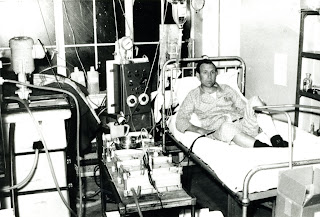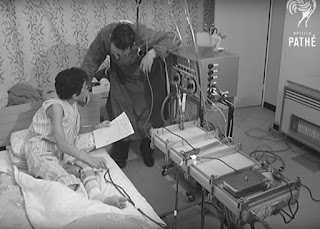Illustration above: Royal Free Hospital home dialysis set-up, 1965
In the early 1960s dialysis was still a very new technology. It was high-tech, life-saving and dramatic. That you can run the the blood of conscious patients through a machine to replace a critical body function is still pretty amazing today. The idea of sending patients home to look after such a new, high-tech treatment themselves themselves must have seemed extraordinary. But dialysis was very expensive, and soon renal units were wrestling with how to stretch their resources to treat as many patients as possible.
The pressures led to dramatic changes in practice on renal units, that often stood in stark contrast to other specialties. Nurses took on tasks that were originally the responsibility of doctors, technicians shared work on the team, even patients shared the work. Dialysis become a nurse-led treatment. Ann Eady recalls how the pressure of increasing numbers led to a transfer of the job of needling the fistulas at Guy’s hospital. These radical changes in renal units probably had much further reaching consequences in medicine than we generally appreciate. Compare these two photos from 1964:

Ray Jones on dialysis at the Royal Free Hospital Olga Heppel on home haemodialysis
Olga Heppel on home haemodialysis
Ray Jones started treatment in 1963 via indwelling arterial and venous femoral catheters, one of the ‘Lucky 13’ at London’s Royal Free Hospital. He is shown above dialysing in hospital surrounded by a forbidding array of dialysis paraphenalia. Olga Heppel was the UK’s first home haemodialysis patient. Some of the earliest UK home dialysis patients appear in the first episode of Tomorrow’s World (7th July 1965), available on the BBC website, but only Olga Heppell was actually on home dialysis at the time. The total number of patients treated in the UK at this time was probably under 50. The film also includes footage of Olga 8 months into treatment, plus discussion of how to choose who to treat, and the implications of the cost of treatment. More about Olga Heppel and the first UK home HD.
Haemodialysis carried out at home was introduced in three units thousands of miles apart in 1964, all responding to the same pressures. In Boston (Merrill) in July, Seattle (Scribner) in September, and in London (Shaldon) in October.
All used Scribner shunts. Some depended on locally made or modified machines, and some of the early patients were healthcare professionals, but quickly the spread widened. In the same year, Boen reported visiting a patient at home in Seattle to carry out intermittent PD by repeated puncture using a rigid catheter. However it was to be two more decades before peritoneal dialysis, as CAPD, could become established as a realistic medium to long term home option.

Home dialysis machine 1966, Science Museum, see below
In 1965 Stanley Shaldon reported that giving the work to patients in the unit, primarily as a cost-saving measure, led to an increase in quality of care and in patients’ independence. By 1968 he was writing about the additional benefits in independence and quality of life from home haemodialysis. Has this changed? Probably not.
Recently there has been some re-discovery of the value of home haemodialysis. Patients doing daily dialysis at home, in particular, report better health and quality of life. Machines are moving toward supporting home haemodialysis better. Getting the numbers really high again is made challenging by the different profile of patients today: older, with more comorbidities and greater dependencies. But it was always the best long term treatment if you couldn’t get a safe transplant, and it probably still is.
Further information
Video: Olga Heppell (this site) – includes 1965 film of her on home haemodialysis.
Video: this vivid 1969 film of an Oxford patient.
Video: First episode of the BBC TV programme Tomorrow’s World in 1965 includes film of Olga Heppell after some months of home treatment. Others in the film went onto home treatment later.
Drs Stanley Shaldon and Rosemarie Baillod really made home haemodialysis happen from 1964. Dr Shaldon left the NHS in 1966 and trained patients from around the world at the National Kidney Centre in London.
The Newcastle and the Royal Free dialysis units are mentioned above.
The Science Museum has Moreen Lewis’ Milton Roy home dialysis machine from 1966, with a nice narrative (photo above).
There is an excellent collection of dialysis equipment in the virtual museum of Home Dialysis Central. This site also has a treasure trove of info for current home dialysis patients, Life@Home articles.
Wellcome Witness to the History of Medicine 2009, History of dialysis in the UK.
Cameron JS 2002. A history of the treatment of renal failure by dialysis. Oxford University Press, Oxford.
KDIGO 2021 report on Controversies in home dialysis, short video summaries and you can download the full report.
Last Updated on May 29, 2024 by neilturn



